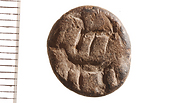
10-year-old finds 3,000-year-old seal in Jerusalem
Russian tourist finds ancient seal while participating in the Temple Mount Sifting Project; it is the first of its kind ever found in Jerusalem.
The seal was discovered at Jerusalem’s Temple Mount Sifting Project. It probably belonged to a high-ranking figure who used it to sign letters and documents.
The sifting of the soil, carried out at the Emek Tzurim National Park in Jerusalem, has been going on for more than a decade under the auspices of Bar-Ilan University, in cooperation with the Ir David Foundation and the Israel Nature and Parks Authority. The project involves sifting through soil illegally removed from the Temple Mount during destructive excavations carried out by the Muslim Waqf at the end of the 90s.
"When my family and I visited Israel, we went on a trip to Jerusalem," recounts Tcepliaev, "there were many interesting things but the most meaningful experience was the visit to the archaeological sifting. They explained to us what to do and we started working. After a while I found something hard, it was an old seal. I was really happy and I ran to the man in charge of the excavations to show him, he told me it was very old and it needed to be analyzed. It was a very joyous discovery."
Hillel, the archaeologist who was there during the find said there was great excitement. "A family of tourists were sifting through the soil, when suddenly one of the workers called me excitedly and asked me to come urgently. To my astonishment and delight I noticed the seal. I immediately gathered everyone who was present and showed them the rare find. I also called my superiors and told them about it. I've been working at the site for almost ten years and this was the first time I had found this kind of seal, one so rare. For me it was really like finding a treasure."
According to Dr. Gabriel Barkay, who runs the excavation site, this is the first time that a Temple Mount artifact from this period was discovered. "The seal has a conical shape, is made of brown limestone, and its height is 16 millimeters. At its round bottom of 14 millimeters are engraved the figures of two animals, one above the other, perhaps a predator and its prey. The seal is pierced, so that it could hang from a string. The carving of the animal figures was done in a linear and schematic way, making it difficult to identify them exactly."
Dr. Barkay said that "stylistically similar seals were discovered across the country, including at Tel Gezer, Tel Beit Shemesh and Tel Rechov, but this is the first time such a seal was discovered in Jerusalem. All the other seals discovered with similar decorations have been dated to the 11th to 10th BC, which is the Jebusites era and the days of the conquest of Jerusalem by David, the construction of the Temple and the kingdom of his son Solomon."
The soil filtering is done by volunteers and tourists coming from Israel and all over the world and so far 170,000 people have participated. "Since an organized excavation has never been carried out on the Temple Mount, our findings provide valuable information not previously available to researchers of Jerusalem," said Zachi Dvira, the founder of the project. "Although the findings were extracted from their archeological context, most of the artifacts can be identified and dated by comparing them with those found at other sites.
“In recent years, using newly developed statistical methodologies and technologies, we have managed to overcome the challenge of having finds with no exact context, since they were not recovered in a proper archeological excavation."












